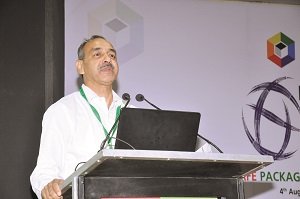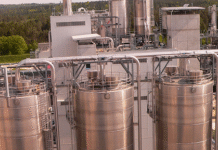The Packaging Conclave held in New Delhi on 4 August was organized concurrently with PackPlus 2017 and focused on package safety as its primary theme. The conclave was conducted in association with Siegwerk, a leading international producer of printing inks and coatings for the packaging industry. Package safety needs to be a collaborative effort involving all stakeholders in the value chain as it encompasses multifarious aspects ranging  from the primary product and its packaging to the supply chain, which includes distribution to consumers and to the related statutory implications and their efficacious monitoring and enforcement. Participation of speakers and delegates from across the entire gamut of brand owners, packaging material suppliers, packaging technologists and professionals, supply chain stakeholders, testing and research organizations, industry associations, consumer fora, government and statutory agencies, academia and trade and scientific media was important and, by and large, people from all these segments turned up at the Packaging Conclave.
from the primary product and its packaging to the supply chain, which includes distribution to consumers and to the related statutory implications and their efficacious monitoring and enforcement. Participation of speakers and delegates from across the entire gamut of brand owners, packaging material suppliers, packaging technologists and professionals, supply chain stakeholders, testing and research organizations, industry associations, consumer fora, government and statutory agencies, academia and trade and scientific media was important and, by and large, people from all these segments turned up at the Packaging Conclave.
As it happened, almost all the deliberations centered on food packaging safety, that is, the migration of unwanted constituents of the packaging system into the product and the hazards generated therefrom. This was probably to be expected as, instinctively, the common man’s mind associates package safety primarily with foods and beverages.
The conclave consisted of three business sessions that followed the keynote. Session 1 was on’ Package Safety: Risk Assessment’; Session 2 was on ‘Migration And Toxicology: A Threat to Consumer Safety’; and Session 3 was called ‘Connecting the Dots.’ The concluding session featured an independent wrap-up of the discussions and some personal observations by a distinguished speaker. The moderator of the conference was Deepak Manchanda, a packaging designer, environmentalist and author.
Kandarp Singh of Tetra Pak delivers keynote
 The keynote address was delivered by Kandarp Singh, managing director of Tetra Pak South Asia Markets—probably the largest international organization in food and beverage packaging operating in India. Singh first highlighted several recent ‘incidents’ in food safety, including the ban on the use of newspapers for wrapping and storing food (direct contact) by FSSAI. He pointed out that food safety issues could cause irreparable damage to companies’ brands and reputation, and emphasized how protecting food and the environment requires an integrated approach involving all stakeholders in the food value chain.
The keynote address was delivered by Kandarp Singh, managing director of Tetra Pak South Asia Markets—probably the largest international organization in food and beverage packaging operating in India. Singh first highlighted several recent ‘incidents’ in food safety, including the ban on the use of newspapers for wrapping and storing food (direct contact) by FSSAI. He pointed out that food safety issues could cause irreparable damage to companies’ brands and reputation, and emphasized how protecting food and the environment requires an integrated approach involving all stakeholders in the food value chain.

At the production level, it is important to source safe and high quality food, to ensure safe and compliant packaging (including state-of-the-art technology and tamper evidence), to integrate production facilities to secure food quality, safety and operational excellence and digitalization of services for greater efficiency and food safety. At the distribution level, it is necessary to achieve efficiency, avoidance of food wastage and visibility; transportation conditions need to be tested to assure protection and all operators need to be trained to properly handle, store and display products. This has to be supplemented by communicating food quality and safety to consumers and improving food safety knowledge and information to help consumers make informed decisions. The government and influencers need to make food safety and sustainability a shared mission. Everybody needs to be committed to sustainability and be uncompromising on food safety.
Session 1 on Risk Assessment was a panel discussion comprising panelists from leading FMCG organizations and the FSSAI. The session chairman was Ashish Pradhan of Siegwerk and the other panelists were Barun Banerjee of Nestle India, Sukhdev Saini of General Mills India, Saikat Acharya of Glaxo Smithkline, Rahul Bhargava of Sun Pharma, and Anil Kumar of FSSAI.
All the panelists at the Packaging Conclave highlighted the fact that it takes years to build up faith and trust in companies’ brands and all this could be undone or destroyed in an instant by an unfortunate food safety ‘incident.’ Several such incidents that made a significant impact on business were cited. The panelists listed examples of how hazards could be created from packaging materials like flexible laminates, cartons, metal cans, glassware, plastic jars and the like; some hazards could be from ingredients of the product formulations themselves or from subsequent contamination of the product. The risks from packaging materials could be divided into several categories like safety (direct impact on health), quality of materials received, non-compliance of materials and packaging systems with legal and statutory requirements, and the efficacy and effectiveness of products (healthcare), all of which lead to poor consumer perception.
HACCP

The panelists recommended the Hazard Analysis and Critical Control Point (HACCP) process as being the best for hazard analysis/assessment and control. The HACCP system was pioneered by General Mills and its origins go back to when NASA approached Pillsbury (a General Mills company) to develop foods that could be eaten at zero gravity as part of its space program. The fundamental proviso was to be 100% certain that the foods could be consumed without injury or illness caused by bacterial pathogens, toxins, chemicals or physical hazards.
The processes they used evolved into HACCP, which is now the internationally adopted system used for food safety by applying traditional inspection methods. HACCP has seven underlying principles that cover identification of hazards, assessment of the probability of their occurrence and severity of impact, making risk control decisions and instituting systems for monitoring and review of the HACCP program. The HACCP system has to be supplemented by an ongoing and continuous vendor audit to ensure compliance with quality standards and statutory regulations in place or imposed afresh from time to time.
FSSAI invites industry participation

Kumar Anil, Advisor (Standards) at Food Safety and Standards Authority of In- dia, traced the setting up of FSSAI under the Food Safety and Standards Act, 2006 for laying down science-based standards for articles of food and to regulate their manufacture, storage, distribution, sale and import to ensure availability of safe and wholesome food for human consumption and for matters connected therewith or incidental thereto. The development of standards by the Food Authority is undertaken by 17 scientific panels, whose recommendations are scrutinized and overseen by a Scientific Committee comprising more than 220 independent experts and scientists. Existing standards already cover several packaging applications listed by end-use and many individual packaging materials.
FSSAI is currently in the process of reviewing the Food Safety and Standards (Packaging and Labelling) Regulations, 2011 and is looking into developing and reviewing existing and new standards including additives and packaging materials that may come into direct contact with foodstuffs. Kumar invited the food and packaging industries to participate in this process and contribute and share their knowledge to the process of development of these standards. The discussions provided very useful insights into risk assessment of potential hazards and methods for monitoring and control of package safety. Additional coverage of the Packaging conclave, especially that pertaining to the considerations and developments of inks in relation to food packaging, will appear in our subsequent issue of Packaging South Asia.
The article was first published in the September 2017 issue of Packaging South Asia.











